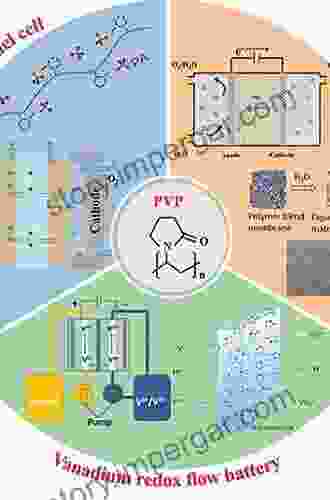Unlocking Electrochemical Energy Storage with Polymer Electrolyte Membranes: A Comprehensive Exploration

5 out of 5
| Language | : | English |
| File size | : | 38541 KB |
| Print length | : | 652 pages |
| Screen Reader | : | Supported |
In the pursuit of a sustainable energy future, electrochemical energy storage technologies have emerged as a cornerstone, enabling the efficient conversion, storage, and release of electrical energy. Among these technologies, polymer electrolyte membranes (PEMs) stand out as a critical component, playing a pivotal role in the advancement of fuel cells and water electrolysis.
This comprehensive article delves into the fascinating realm of PEMs, exploring their fundamental principles, materials, and applications in electrochemical energy storage. By understanding the intricate interplay between these aspects, readers will gain a deep appreciation of the potential of PEMs to revolutionize the energy landscape.
Delving into the World of Polymer Electrolyte Membranes
Polymer electrolyte membranes are a class of solid-state materials that possess both ionic and electronic conductivity, making them ideal for applications in electrochemical devices, such as fuel cells and batteries. PEMs consist of a polymer matrix that is impregnated with an ionic conductor, typically an acid or alkaline salt. This combination endows PEMs with the ability to conduct protons or other ions while blocking the passage of electrons.
The unique electrochemical properties of PEMs arise from the presence of hydrophilic and hydrophobic domains within their structure. The hydrophilic domains facilitate the transport of ions, while the hydrophobic domains hinder the movement of electrons. This delicate balance of properties allows PEMs to function as selective barriers in electrochemical cells, promoting efficient charge separation and ion transport.
Materials and Fabrication of PEMs
The development of high-performance PEMs hinges on the judicious selection and synthesis of appropriate materials. Common polymer matrices for PEMs include perfluorinated sulfonic acid (PFSA) polymers, such as Nafion, and hydrocarbon-based polymers, such as polyethersulfone (PES).
Ionic conductors are typically incorporated into the polymer matrix through various techniques, such as doping or blending. For example, in PFSA-based PEMs, the ionic conductor is typically a perfluorinated sulfonic acid salt, such as Nafion ionomer. The choice of ionic conductor influences the conductivity, stability, and other properties of the PEM.
The fabrication of PEMs involves a series of steps, including polymer synthesis, ion exchange, and membrane formation. Precise control over these processes is crucial to achieve the desired electrochemical performance and structural integrity.
Applications of PEMs in Electrochemical Energy Storage
The remarkable properties of PEMs make them indispensable components in various electrochemical energy storage devices, including fuel cells, water electrolysis systems, and batteries.
Fuel Cells
PEM fuel cells are electrochemical devices that convert chemical energy stored in hydrogen or other fuels into electrical energy. PEMs serve as the electrolyte membrane in these cells, separating the anode and cathode compartments. Protons generated at the anode pass through the PEM to the cathode, where they combine with oxygen to produce water and release energy in the form of electricity.
Water Electrolysis
Water electrolysis systems use electricity to split water into hydrogen and oxygen, offering a clean and sustainable method for hydrogen production. PEMs are employed as the electrolyte membrane in these systems, facilitating the transfer of protons between the anode and cathode. The generated hydrogen gas can be used as a clean fuel in various applications.
Batteries
PEMs also find applications in batteries, where they act as separators between the positive and negative electrodes. The ion-conducting properties of PEMs enable the movement of ions during the charging and discharging processes, while the electron-blocking properties prevent short circuits.
Challenges and Future Prospects of PEMs
Despite their immense potential, PEMs face several challenges that need to be addressed for widespread adoption. These include:
- Cost and scalability
- Durability and stability
- Performance under extreme conditions
Ongoing research and development efforts are focused on overcoming these challenges and advancing the performance and durability of PEMs. New materials and fabrication techniques are being explored to enhance conductivity, reduce cost, and improve stability. Additionally, the development of advanced characterization tools is enabling a deeper understanding of the structure-property relationships in PEMs.
Electrochemical polymer electrolyte membranes are a critical component in the development of advanced electrochemical energy storage technologies. Their unique electrochemical properties and versatility make them essential for fuel cells, water electrolysis systems, and batteries. As the field of electrochemical energy storage continues to evolve, PEMs are poised to play an increasingly vital role in the transition to a more sustainable and decarbonized energy future.
This comprehensive exploration of PEMs has provided an in-depth understanding of their fundamental principles, materials, and applications. By harnessing the potential of PEMs, we can unlock new avenues for efficient energy conversion, storage, and release, paving the way for a greener and more sustainable tomorrow.
5 out of 5
| Language | : | English |
| File size | : | 38541 KB |
| Print length | : | 652 pages |
| Screen Reader | : | Supported |
Do you want to contribute by writing guest posts on this blog?
Please contact us and send us a resume of previous articles that you have written.
 Book
Book Novel
Novel Page
Page Chapter
Chapter Text
Text Story
Story Genre
Genre Reader
Reader Library
Library Paperback
Paperback E-book
E-book Magazine
Magazine Newspaper
Newspaper Paragraph
Paragraph Sentence
Sentence Bookmark
Bookmark Shelf
Shelf Glossary
Glossary Bibliography
Bibliography Foreword
Foreword Preface
Preface Synopsis
Synopsis Annotation
Annotation Footnote
Footnote Manuscript
Manuscript Scroll
Scroll Codex
Codex Tome
Tome Bestseller
Bestseller Classics
Classics Library card
Library card Narrative
Narrative Biography
Biography Autobiography
Autobiography Memoir
Memoir Reference
Reference Encyclopedia
Encyclopedia Roberto Verganti
Roberto Verganti Maria Barnes
Maria Barnes Peter Goldie
Peter Goldie Theresa Dodaro
Theresa Dodaro Marybeth Smith
Marybeth Smith Pascal Quignard
Pascal Quignard Matt Matros
Matt Matros Martin Beech
Martin Beech Thomas F Madden
Thomas F Madden Soo Ah Kwon
Soo Ah Kwon Mark C Taylor
Mark C Taylor Matthew Yao
Matthew Yao Mardi Link
Mardi Link Pamela Jane Rogers
Pamela Jane Rogers Maxine Harris
Maxine Harris Maurice Chavez
Maurice Chavez Xenophon
Xenophon Nick Cato
Nick Cato Mariano Sigman
Mariano Sigman Mark W Moffett
Mark W Moffett
Light bulbAdvertise smarter! Our strategic ad space ensures maximum exposure. Reserve your spot today!

 Thomas PynchonRollodores, Dead Heads, and Side Wheelers: A Journey Through the Golden Age...
Thomas PynchonRollodores, Dead Heads, and Side Wheelers: A Journey Through the Golden Age...
 Marcus BellUnlock the Secrets of Your Emotional Brain: Dive into the World-Renowned "The...
Marcus BellUnlock the Secrets of Your Emotional Brain: Dive into the World-Renowned "The... Ian MitchellFollow ·16.6k
Ian MitchellFollow ·16.6k John ParkerFollow ·15.9k
John ParkerFollow ·15.9k Herbert CoxFollow ·17.9k
Herbert CoxFollow ·17.9k Dashawn HayesFollow ·16.8k
Dashawn HayesFollow ·16.8k Ben HayesFollow ·12.6k
Ben HayesFollow ·12.6k Jace MitchellFollow ·12.1k
Jace MitchellFollow ·12.1k Octavio PazFollow ·14.3k
Octavio PazFollow ·14.3k Fred FosterFollow ·12.8k
Fred FosterFollow ·12.8k

 Roberto Bolaño
Roberto BolañoUnveiling the Beauty and History of the Medici Iris: A...
In the realm of...

 Theodore Mitchell
Theodore MitchellImproving Gut Health in Poultry: Unlocking the Path to...
In the ever-evolving field of...

 Victor Hugo
Victor HugoPersonalized Medicine with a Nanochemistry Twist:...
The future of healthcare...

 George Martin
George MartinA Year Of Wine: Perfect Pairings Great Buys And What To...
## Year of Wine: An Epic Journey Through the...

 Tom Hayes
Tom HayesDelve into the Enigmatic World of Southern Africa's...
Embark on a captivating journey through the...
5 out of 5
| Language | : | English |
| File size | : | 38541 KB |
| Print length | : | 652 pages |
| Screen Reader | : | Supported |










